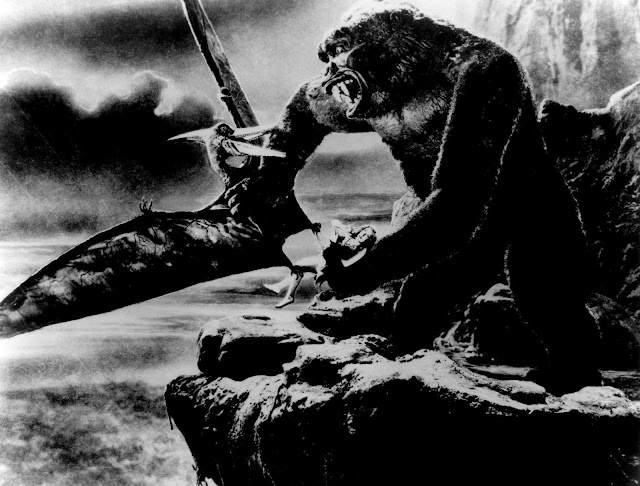King Kong (1933)
Merian C. Cooper & Ernest B. Schoedsack's "King Kong"
There are many post-Depression American 'box office' films that I have seen in my film studies journey. Most of these post-Depression box office films don't typically sit right with me. The films I have in mind are the gangster and monster films that swept the nation in the early 1930s. These films typically were meant to placate an anxious American audience. However, the depth to their thematic intricacies leave something to be desired. Even without this depth, the 'entertainment' aspect of these films were not very entertaining to me. However, there is one film that utterly surprised me, 1933's adventure epic "King Kong."
The story is well-known. A group of filmmakers travel to a remote island to take advantage of strange and interesting natural wildlife unknown to the outside world. There they meet an indigenous people, all terrified of a large, monstrous primate living on the other side of a man-made wall. After they sacrifice the young, blonde movie star to the monster, it 'falls in love with her.' After saving the woman from the beast, they capture it and take it back to New York City to show it in an exhibition. It gets loose, takes the woman, and climbs to the top of the Empire State Building, where it is shot down by fighter planes.
To preface my admiration for this film, I will note that the film is incredibly misogynistic. It was irritating to watch the attitude felt by the only female character in the film (that of disdain and disregard). Despite these of-the-era attitudes, the film was still a marvel to behold. Before mentioning the incredible special effects of the film, its interesting to note the thematic story at play. These filmmakers and adventurers are looking to exploit the natural world in order to create sensationalism and awe within an audience. Much like with their attitude towards the woman, they have a disdain for the thing with which they seek to exploit. But, they persist because its the exact kind of sensational beauty, terror, amazement, etc. that would drive box office numbers. They are looking to excite and amaze in the story and the same is accomplished with the film itself.
They excite and amaze, especially through the use of their ingenious special effects. Looking back today, it might be amusing to belittle the 'archaic' special effects if you're comparing them to today's digital era. However, I would argue that this level of artistry is as impressive today as it was in 1933. For the iconic Kong, stop-motion animation was painstakingly used to create the beast. This stop-motion animation was combined with live-action footage seamlessly to make the interaction between humans and beasts believable. The filmmakers would expose part of the frame and then run that same piece of the film through the camera again by exposing the other part of the frame with a different image. The results are immaculate. As a viewer, I was absolutely floored by what I saw.
In the end, the sensational extravaganza a showing Kong proved to blow back in their face. They wanted to wow their viewer. But by doing so, they released something beyond their control. That's exactly what Merian C. Cooper and Ernest B. Schoedsack did with the film. They accomplished the unimaginable and from that moment on, Hollywood would never be the same again. Every large-scale box office film would forever attempt to replicate the majesty of "King Kong," as growing technology and innovation surged into filmmaking to create more complex imagery with bigger and better sensational pieces of entertainment. The next time you sit down for a Godzilla film, a Jurassic Park movie, or another King Kong expo, its important to remember just where these movies get their adventurous spirit from.




Comments
Post a Comment